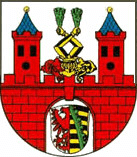The Reformation City of Bernburg
Germany
Bernburg

Where the prince himself slipped through the narrow Gateway
The town of Bernburg on the River Saale lies in the heart of Saxony-Anhalt between the cities of Magdeburg and Halle. Anhalt’s former residential site was first mentioned in official registers in the year 961.
The Reformation history of Bernburg is closely linked with the activities of Prince Wolfgang von Anhalt-Köthen (1492-1566), who entered into government at the age of sixteen in 1508. It was at the Imperial Diet of Worms that he met Martin Luther in 1521, after which he proceeded to instigate the Reformation in the region of Köthen in 1525 and then Bernburg in 1526, by celebrating Protestant Holy Communion in dual form in the Marienkirche. This made Bernburg one of the Empire’s first Protestant territories. Prince Wolfgang represented the interests of the Protestant estates, joined the League of Torgau and the Schmalkaldic League, and was one of the six princely proponents of the Protestation at the Imperial Diet of Speyer in 1529. He was a signatory of the Confessio Augustana at the Imperial Diet of Augsburg in 1530.
The castle museum of Bernburg holds one of the oldest and most valuable editions of Luther’s Works. Of the original twelve volumes published between 1548 and 1583, today only ten survive and remain in good condition. Volume II is without any doubt the most precious of the entire collection. It was crafted in 1548 by Hans Lufft, one of the first Wittenberg Bible printers and booksellers.
A unique stone memorial to the Princely Reformation adorns the round oriels of Schloss Bernburg in the form of half reliefs depicting the German princes, which are collectively known as the “Luminaire”. Prince Wolfgang von Anhalt-Köthen appointed the northern Bohemian master builder Andreas Günther to construct the nave’s oriels. He commissioned images of himself along with John Frederick the Magnanimous, Elector of Saxony, Prince George III of Anhalt-Dessau, Prince Joachim of Anhalt, Johann Ernst of Saxony-Coburg, Duke Philipp of Braunschweig, Prince-Elector Joachim II of Brandenburg and, out of loyalty, besides all these Protestant princes Catholic Emperor Charles V. The originals of the reliefs are housed in the lapidarium of Schloss Bernburg’s museum. The “Luminaire” is currently being restored so that it might shine in its full glory for the 2017anniversary.
In 2008, the town of Bernburg (Saale) erected a stainless steel pedestal in the spa gardens to commemorate the legend of the “Wolfgangspforte” (Wolfgang’s Gateway). When the Protestants lost the Schmalkaldic War in the Battle of Mühlberg in 1547, Prince Wolfgang’s defeat led to the occupation of Bernburg. The prince himself is said to have fled the town using an escape hatch in the Servite Monastery. This gateway was walled up as part of renovation works in the times of the GDR and cannot be re-opened. The commemorative pedestal and faint outlines in the original masonry work are the only testament to the history of the “Wolfgangspforte” on the southern side of the monastery in what are now the spa gardens.
The town of Bernburg (Saale) has always been an important landmark on the Luther Trail in Saxony-Anhalt and became a member of the Luther Trail Association in 2013. On 18 May 2017, Bernburg will form the final stop-over on the European Reformation Roadmap before it reaches Lutherstadt Wittenberg.
Links
The town of Bernburg (Saale) (in German only) www.bernburg.de
Bernburg Tourist Office (in German only) www.bernburger-freizeit.de
Bernburg Church Community (in German only) www.landeskirche-anhalts.de/gemeinden/bernburg
Evangelical Regional Church in Anhalt (in German only) www.landeskirche-anhalts.de

